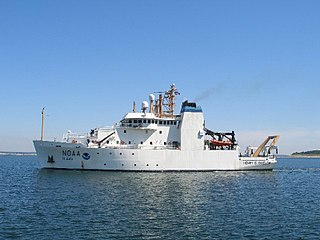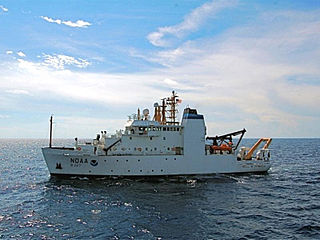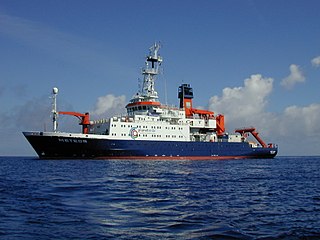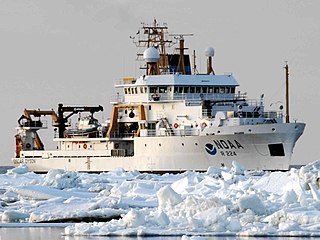
Alvin (DSV-2) is a crewed deep-ocean research submersible owned by the United States Navy and operated by the Woods Hole Oceanographic Institution (WHOI) in Woods Hole, Massachusetts. The vehicle was built by General Mills' Electronics Group in Minneapolis, Minnesota. Named to honor the prime mover and creative inspiration for the vehicle, Allyn Vine, Alvin was commissioned on June 5, 1964. The submersible is launched from the deep submergence support vessel RV Atlantis (AGOR-25), which is also owned by the U.S. Navy and operated by WHOI. The submersible has made more than 5,000 dives, carrying two scientists and a pilot, to observe the lifeforms that must cope with super-pressures and move about in total darkness, as well as exploring the wreck of Titanic. Research conducted by Alvin has been featured in nearly 2,000 scientific papers.

A research vessel is a ship or boat designed, modified, or equipped to carry out research at sea. Research vessels carry out a number of roles. Some of these roles can be combined into a single vessel but others require a dedicated vessel. Due to the demanding nature of the work, research vessels may be constructed around an icebreaker hull, allowing them to operate in polar waters.

A multibeam echosounder (MBES) is a type of sonar that is used to map the seabed. It emits acoustic waves in a fan shape beneath its transceiver. The time it takes for the sound waves to reflect off the seabed and return to the receiver is used to calculate the water depth. Unlike other sonars and echo sounders, MBES uses beamforming to extract directional information from the returning soundwaves, producing a swathe of depth soundings from a single ping.
The Muirfield Seamount is a submarine mountain located in the Indian Ocean approximately 130 kilometres southwest of the Cocos (Keeling) Islands. The Cocos Islands are an Australian territory, and therefore the Muirfield Seamount is within Australia's Exclusive Economic Zone (EEZ). The Muirfield Seamount is a submerged archipelago, approximately 2.5 kilometres in diameter and 16–18 metres below the surface of the sea. A 1999 biological survey of the seamount performed by the Australian Commonwealth Scientific and Industrial Research Organisation (CSIRO) revealed that the area is depauperate.

RV Hugh R. Sharp is a research vessel owned and operated by the University of Delaware College of Earth, Ocean, and Environment in Lewes, Delaware operating as a member of the University-National Oceanographic Laboratory System (UNOLS). She is a replacement for Cape Henlopen.

USNS Relentless (T-AGOS-18) was a Stalwart-class modified tactical auxiliary general ocean surveillance ship in service in the United States Navy from 1990 to 1993. Since 1998, she has been in commission in the National Oceanic and Atmospheric Administration (NOAA) fleet as the fisheries research ship NOAAS Gordon Gunter.

The Institute of Marine Sciences (IMS) is a Turkish facility that focuses on marine science-related education and research. IMS was founded in 1975 on the Erdemli Campus at METU in Erdemli / Mersin. Institute's campus at Erdemli, houses laboratories, office buildings, computing and remote sensing facilities, a library, an atmospheric tower, and other services. Housing for staff and students, and harbor facility are also located on the campus.

NOAAS Henry B. Bigelow is a fisheries research vessel operated by the United States' National Oceanic Atmospheric Administration (NOAA). She is the second in a class of five new fisheries research vessels. She is named after Henry Bryant Bigelow (1879-1967), the American oceanographer, zoologist, and marine biologist who founded the Woods Hole Oceanographic Institution in Woods Hole, Massachusetts.

NOAAS Bell M. Shimada is an American fisheries research ship in commission with the National Oceanic and Atmospheric Administration (NOAA) since 2010. She operates along the United States West Coast.

NOAAS Reuben Lasker is a National Oceanic and Atmospheric Administration (NOAA) fishery research vessel. The ship's namesake, Reuben Lasker, was a fisheries biologist who served with the Southwest Fisheries Center, National Marine Fisheries Service, and taught at the Scripps Institution of Oceanography. This class of NOAA ships is very similar to, and based in part upon, the Neil Armstrong-class Oceanographic Research (AGOR) ships owned by the Office of Naval Research and operated by various US Universities.

Meteor was a German survey vessel, noted for her survey work in the Atlantic Ocean between 1925 and 1927. Handed over to the Soviet Union following World War II, the ship was renamed Ekvator. Her ultimate fate is not known.

RV Tangaroa is a research vessel operated by the National Institute of Water and Atmospheric Research (NIWA) of New Zealand. It was purpose-built as a Deepwater Research Vessel for the then Ministry of Agriculture and Fisheries Research Centre at a cost of $27 million to replace the ageing GRV James Cook. It has a DNV classification of 1A1 and Ice 1C. It was transferred to the new National Institute of Water and Atmospheric Research in 1992.

The RV Southern Surveyor was an Australian marine research vessel. It was owned and managed by the Commonwealth Scientific and Industrial Research Organisation (CSIRO), with its operations funded by the Australian Government to undertake oceanographic, geoscience, ecosystem and fisheries research. It was built in the UK in 1972 and acquired by CSIRO in 1988. It was replaced in 2014 by the RV Investigator.

The RV Meteor is a multidisciplinary research vessel operating mainly on the high sea. She is owned by the German state represented by its Federal Ministry of Education and Research and registered in Hamburg.

NOAAS Oscar Dyson is an American fisheries and oceanographic research vessel in commission in the National Oceanic and Atmospheric Administration (NOAA) fleet since 2005.

NOAAS Pisces is an American fisheries and oceanographic research vessel in commission in the National Oceanic and Atmospheric Administration (NOAA) fleet since 2009.

Leanne Armand was an Australian professor of marine science. She was an expert in the identification of diatoms in the Southern Ocean. She was known for her contributions to the understanding of past Southern Ocean dynamics and sea ice as a result of her knowledge of diatom distributions and ecology.

CSIRO Oceans and Atmosphere (O&A) (2014–2022) was one of the then 8 Business Units of the Commonwealth Scientific and Industrial Research Organisation (CSIRO), Australia's largest government-supported science research agency. In December 2022 it was merged with CSIRO Land and Water to form a single, larger Business Unit called simply, "CSIRO Environment".
RSVNuyina is an icebreaking research and supply vessel intended to support Australian scientific activities and research bases in Antarctica. Capable of deploying a wide range of vehicles, including helicopters, landing barges and amphibious trucks to support the resupply operation, the new ship provides a modern platform for marine science research in both sea ice and open water with a large moon pool for launching and retrieving sampling equipment and remotely operated vehicles.
Moninya Roughan is a professor of Oceanography at the University of New South Wales Australia,. Roughan is the head of the Coastal and Regional Oceanography Lab and is an authority on the oceanography of the East Australian Current. She has led major projects for industry, government, the Australian Research Council and the New Zealand Ministry of Business Innovation and Employment. She has held leadership roles in Australia's Integrated Marine Observing System since 2007.

















